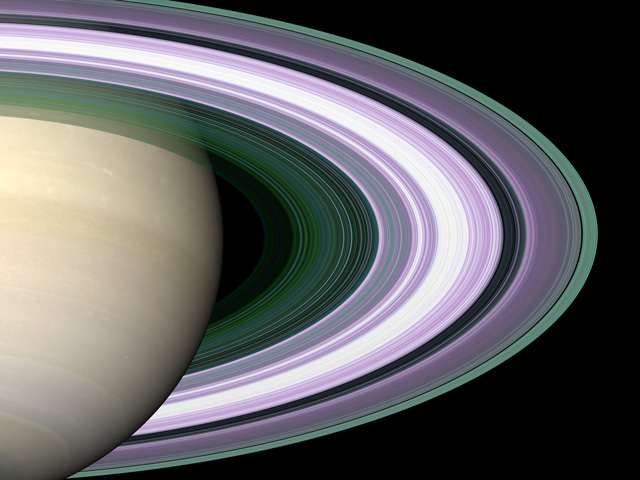Explanation: What size particles compose Saturn's rings? To help find out, the robot Cassini spacecraft now orbiting Saturn broadcast radio waves of three different wavelengths right through the rings to Earth earlier this month. The experiment was sensitive to ring particle sizes because ring particles much larger than a broadcast radio wavelength will reflect those radio waves away. Three different wavelengths were used: approximately 1 centimeter, 3.5 centimeters, and 13 centimeters. The results are coded into the above false-color digitally reconstructed image. In the above image, the color purple indicates regions populated predominantly by ring particles larger than 5 centimeters, while the color green indicates regions with a significant population of small ring particles less than even 1 centimeter. The white center of Saturn's B-ring indicates that the density of ring particles was too high to make a good determination. Other radio observations indicate that some ring particles can be as large as several meters across. The impressive nature and clarity of the above sharp image may help determine clues about the origin of Saturn's beautiful but enigmatic ring system.
1999 2000 2001 2002 2003 2004 2005 2006 2007 2008 2009 2010 2011 2012 2013 2014 2015 2016 2017 2018 2019 2020 2021 2022 2023 2024 2025 |
Yanvar' Fevral' Mart Aprel' Mai Iyun' Iyul' Avgust Sentyabr' Oktyabr' Noyabr' Dekabr' |
NASA Web Site Statements, Warnings, and Disclaimers
NASA Official: Jay Norris. Specific rights apply.
A service of: LHEA at NASA / GSFC
& Michigan Tech. U.
|
Publikacii s klyuchevymi slovami:
Saturn - kol'ca Saturna - radiovolny
Publikacii so slovami: Saturn - kol'ca Saturna - radiovolny | |
Sm. takzhe:
Vse publikacii na tu zhe temu >> | |
